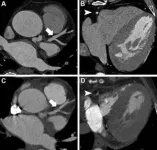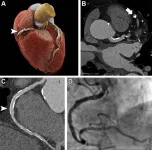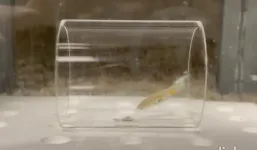(Press-News.org) The Intergovernmental Panel on Climate Change Fifth Assessment Report (AR5), released just prior to an international climate convention in 2015, explicitly stated that human-caused greenhouse gas emissions were the highest in history, with clear and widespread impacts on the climate system. Since then, hundreds of cities across the world have published their own climate action plans (CAPs), detailing how their urban areas will handle climate change. How do the plans stack up against one another and against the recommended guidelines established by the United Nations-Habitat Guiding Principles for City Climate Action Planning?
To better understand the content and structure of these CAPs — and what lessons may be learned from them — researchers from Hiroshima University analyzed 278 urban CAPs established since 2015.
They published their findings on May 10 in Urban Climate.
“There is limited knowledge about the global situation of the content and structure of urban CAPs adopted or published after AR5 — most existing studies are either limited in geographical scope or thematic focus,” said first author Prince Dacosta Aboagye, a doctoral student in Hiroshima University’s Graduate School of Humanities and Social Sciences. “In this study, we critically analyze the content and structure of urban CAPs adopted or published post-AR5 and examine how these urban CAPs align with selected climate action planning best practices.”
According to Aboagye, cities are vulnerable to climate change, but city governments also possess the local knowledge and close community connections to effectively engage with their citizens to achieve urban climate targets. They also wield the authority to adopt laws and legislation to reduce urban emissions and adapt as needed.
“Our study extends the analysis and presents a global perspective on the content and structure of urban CAPs and the extent to which urban CAPs align with selected climate action planning best practices,” Aboagye said. “This critical analysis of the content and structure of urban CAPs across a taxonomy and typology of cities provides additional insights for local climate decision-making and the development of more robust climate planning frameworks.”
Using international databases of urban city plans and Google, the researchers identified 278 CAPs that were published in English between 2015 and 2022. According to Aboagye, while there was initial concern that the English requirement may introduce bias, the final sample included cities from across Africa, Asia, Europe, the Americas and Oceania.
The researchers applied a qualitative analysis to identify key climate action planning elements, such as the co-benefits, synergies, trade-offs and conflicts in the reports. They also identified trends in urban CAP adoption, areas of focus, pledges to reduce greenhouse gas emissions and to achieve zero carbon, as well as how baseline greenhouse gas emission inventory is reported.
“There have been variations in the adoption or publication of urban CAPs post-AR5 across city types and world regions,” said corresponding author Ayyoob Sharifi, professor in Hiroshima University’s IDEC Institute. “Cities have transitioned from developing only mitigation-related plans to both mitigation and adaptation. Almost half of the sampled mitigation-related urban CAPs have a deep decarbonization target, with less than a quarter likely to be achieved by 2030.”
The researchers found that CAPs were increasingly adopted and published from 20 in 2015 to 56 in 2020, with cities leveraging social media and teleconferencing platforms to adopt or publish their plans. Most of the 278 plans included both mitigation and adaption plans, but 3% focused solely on adaption and 16% on mitigation. Of the sectors targeted to achieve climate objectives, 268 CAPs focused most on transportation, followed closely by the energy, buildings and waste sectors. The researchers also analyzed connections between the sectors and how cities considered potential co-benefits in their planning, finding that cities are more likely to focus on these linked sectors over others: transport and energy; transport and waste; energy and waste; transport and urban governance/policy/planning; and energy and urban governance/policy/planning.
According to Sharifi, the researchers plan to use their findings to develop an integrated and comprehensive urban climate planning framework to serve as a guiding tool for developing robust climate action plans with globally accepted benchmarks, criteria and standards.
“We hope the paper’s evidence will shape future urban climate planning since it highlights lessons from urban CAPs adopted or published from 2015 to 2022,” Sharifi said. “Next, we will use the planned framework to evaluate the suitability of urban CAPs and build the capacity of local governments and urban planners to adopt the framework to develop suitable city-specific CAPs.”
##
About Hiroshima University
Since its foundation in 1949, Hiroshima University has striven to become one of the most prominent and comprehensive universities in Japan for the promotion and development of scholarship and education. Consisting of 12 schools for undergraduate level and 4 graduate schools, ranging from natural sciences to humanities and social sciences, the university has grown into one of the most distinguished comprehensive research universities in Japan. English website: https://www.hiroshima-u.ac.jp/en
END
Climate action plans mobilize limited urban change, researchers report
Adaption and mitigation efforts might be improved with inclusivity and transparency
2023-06-20
ELSE PRESS RELEASES FROM THIS DATE:
Photon-counting CT noninvasively detects heart disease in high-risk patients
2023-06-20
OAK BROOK, Ill. – New ultra-high-resolution CT technology enables excellent image quality and accurate diagnosis of coronary artery disease in high-risk patients, a potentially significant benefit for people previously ineligible for noninvasive screening, according to a study published in Radiology, a journal of the Radiological Society of North America (RSNA).
Coronary artery disease is the most common form of heart disease. Coronary CT angiography (CCTA) is highly effective for ruling out coronary artery disease ...
Self-driving revolution hampered by a lack of accurate simulations of human behavior
2023-06-20
Self-driving revolution hampered by a lack of accurate simulations of human behaviour
Algorithms that accurately reflect the behaviour of road users - vital for the safe roll out of driverless vehicles - are still not available, warn scientists.
They say there is “formidable complexity” in developing software that can predict the way people behave and interact on the roads, be they pedestrians, motorists or bike riders.
To improve the modelling, a research team led by Professor Gustav Markkula from the Institute of Transport Studies ...
Toxic emissions from wildland-urban interface fires
2023-06-20
Fires in the wildland-urban interface (WUI) emit more toxic smoke than wildfires burning in natural vegetation, due to the chemicals in the structures, vehicles, and other manufactured goods that burn in fires in areas of human habitation. Amara Holder and colleagues surveyed the literature on emissions from urban fuels, finding 28 experimental studies that reported emission factors—emissions per unit of fuel burned—for various items, such as home furnishings, consumer electronics, and vehicle ...
Electing progressives with patriotism, family, and tradition
2023-06-20
Economically progressive candidates may fare better in US elections when delivering their message in terms of “binding values” such as patriotism, family, and respect for tradition, according to a study. Although large majorities of Americans favor increasing economic equality in the United States, candidates who promote policies intended to reduce economic inequality, such as raising the minimum wage or increasing access to health care, often fare poorly at the ballot box. One reason for their under-performance may ...
Locating executive functions in fish brains
2023-06-20
The telencephalon is the part of the brain responsible for executive functions in fish, according to an experimental study. Zegni Triki and colleagues used guppies (Poecilia reticulata) that had been selected over five generations to have smaller or larger telencephalons, resulting in a 10% size difference between “up selected” and “down selected” lines of fish. Total brain size was not significantly affected. The authors then presented 48 male fifth-generation fish from both lines with tests of cognitive flexibility, inhibitory control, and working memory—the three commonly accepted components ...
Modeling human behavior for autonomous vehicles
2023-06-20
A model of human psychology could help self-driving cars interact with human drivers on the road, according to a study. Gustav Markkula and colleagues combined several computational psychological models into one master-model to simulate pedestrians attempting to cross a busy road and the human drivers on that road. The goal of the model was to capture the underlying cognitive mechanisms responsible for observed behavior. Computational models of Bayesian perception, theory of mind, behavioral game theory, long-term valuation of ...
Cholesterol lures in coronavirus
2023-06-20
A recent study unveiled the doorway that SARS-CoV2 uses to slip inside cells undetected.
SARS-CoV-2 uses the receptor angiotensin-converting enzyme 2, or ACE2, to infect human cells. However, this receptor alone does not paint a complete picture of how the virus enters cells. ACE2 is like a doorknob; when SARS-CoV-2 grabs it and maneuvers it precisely, this allows the virus to open a doorway to the cell’s interworking and step inside. However, the identity of the door eluded scientists.
Scott Hansen, an associate ...
2023 Warren Alpert Foundation Prize honors pioneer in computational biology
2023-06-20
The 2023 Warren Alpert Foundation Prize has been awarded to scientist David J. Lipman for his visionary work in the conception, design, and implementation of computational tools, databases, and infrastructure that transformed the way biological information is analyzed and accessed freely and rapidly around the world.
The $500,000 award is bestowed by The Warren Alpert Foundation in recognition of work that has improved the understanding, prevention, treatment, or cure of human disease. The prize is administered by Harvard Medical School.
Lipman will be honored at a scientific symposium on Oct. 11, 2023, hosted by HMS. For further information, visit ...
How good or evil are you when gaming?
2023-06-20
Two papers published by Macquarie University researchers reveal that most of us ignore the meter when a moral choice is clear, but we use it when the choice is more morally ambiguous. And some of us, about ten per cent, will do anything to win.
You are playing The Great Fire, a narrative computer game. It’s all about Frankie, an usher in a cinema in regional Australia in the 1940s, who is confronted by a murderous psychopath.
Along the way, players have to make choices which affect the progress and outcome of the game. Some are simple black and white decisions, such as ...
Walkable neighborhoods help adults socialize, increase community
2023-06-20
Adults who live in walkable neighborhoods are more likely to interact with their neighbors and have a stronger sense of community than people who live in car-dependent communities, report researchers at the Herbert Wertheim School of Public Health and Human Longevity Science at University of California San Diego.
The findings of the study, published online in the journal Health & Place, support one of six foundational pillars suggested by United States Surgeon General Vivek Murthy as part of a national strategy to address a public health crisis caused by loneliness, ...
LAST 30 PRESS RELEASES:
University of Phoenix College of Doctoral Studies releases white paper on AI-driven skilling to reduce burnout and restore worker autonomy
AIs fail at the game of visual “telephone”
The levers for a sustainable food system
Potential changes in US homelessness by ending federal support for housing first programs
Vulnerability of large language models to prompt injection when providing medical advice
Researchers develop new system for high-energy-density, long-life, multi-electron transfer bromine-based flow batteries
Ending federal support for housing first programs could increase U.S. homelessness by 5% in one year, new JAMA study finds
New research uncovers molecular ‘safety switch’ shielding cancers from immune attack
Bacteria resisting viral infection can still sink carbon to ocean floor
Younger biological age may increase depression risk in older women during COVID-19
Bharat Innovates 2026 National Basecamp Showcases India’s Most Promising Deep-Tech Ventures
Here’s what determines whether your income level rises or falls
SCIE indexation achievement: Celebrate with Space: Science & Technology
Children’s Hospital Colorado performs region’s first pediatric heart and liver dual organ transplant
Australian team discover why quantum computers have memory problems over time
What determines the fate of a T cell?
Candida auris: genetic process revealed which could be treatment target for deadly fungal disease
Groundbreaking discovery turns household plastic recycling into anti-cancer medication
Blocking a key inflammatory pathway improves liver structure and vascular function in cirrhosis, study finds
Continuous spread: Raccoon roundworm detected in nine European countries
HKUST Engineering researchers developed a novel photodetector to enhance the performance of on-chip light monitoring
Strategic river sensors could have forewarned of Texas Camp flood disaster
Drone sampling of whale breath reveals first evidence of potentially deadly virus in Arctic
Roman soldiers defending Hadrian’s Wall infected by parasites, study finds
Pinochet’s prisoners were tormented with music but still found solace in it, a new book reveals
Fertility remains high in rural Tanzania despite access to family planning
AI-assisted device can improve autism care access
Kinetic careers
Uncovering how parasitic plants avoid attacking themselves to improve crop resistance
Nanoparticle vaccine strategy could protect against Ebola and other deadly filoviruses
[Press-News.org] Climate action plans mobilize limited urban change, researchers reportAdaption and mitigation efforts might be improved with inclusivity and transparency








